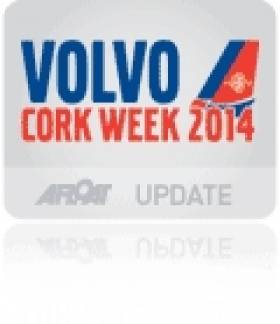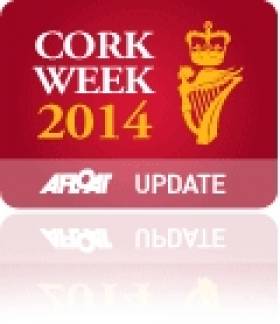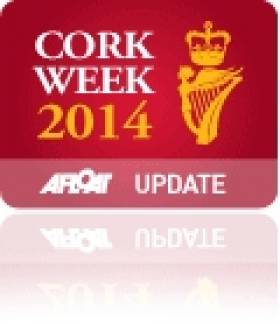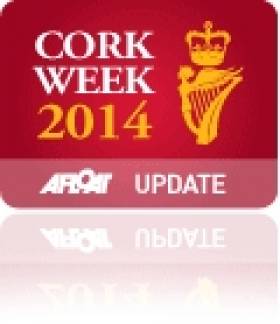Displaying items by tag: Volvo
Volvo to Sponsor Round Ireland Yacht Race in 2016
Volvo Car Ireland has added June's Round Ireland Yacht Race to its Irish sailing sponsorships. The car brand adds the 700–mile offshore race to its existing sponsorship of Ireland's other Grand Prix biennial sailing events; Dun Laoghaire Regatta and Cork Week.
While no official figure has been released, in previous years the title sponsorship of the race has been valued upwards of €50,000, according to an RTE report.
Run by Wicklow Sailing Club, the Round Ireland Yacht Race is the only RORC (Royal Ocean Racing Club) race based in Ireland and is one of the longest offshore races in the Royal Ocean Racing Club calendar, taking up to 7 days to complete. The first race took place in 1980 with only thirteen boats. Since then, held biennially, the fleet has grown steadily, attracting a record sixty boats.
The Race is regarded as near equivalent in terms of rating points to the Fastnet Race, the classic offshore race, which runs in alternate years to the Round Ireland. The course, starting and finishing in Wicklow, brings entrants through widely different sea types and coastlines, from the Atlantic Ocean to the more sheltered Irish Sea, with difficult tidal gates, particularly around the North Eastern coast and navigational challenges requiring day and night tactical decisions at every change of forecast.
The Volvo sponsorship comes at a pivotal time in the Race’s development. Last year saw the establishment of a Dún Laoghaire base through a partnership with the Royal Irish Yacht Club, providing facilities thereby allowing larger yachts to compete. Race organisers have also just announced a further expansion to include a multi-hull category for the first time ever in its 36 year history.
Since the multi-hull expansion was announced, a UK giant 70-foot trimaran is already planning to compete in the 2016 edition of the race.
Adrian Yeates, Managing Director Volvo Car Ireland commented:
Volvo Car Ireland is proud to be so closely involved with such a prestigious sailing event as the Round Ireland Yacht Race. The Volvo Ocean Race is the world’s leading offshore race and is a truly global event, involving state-of-the-art boats and high-performance competition sailing on the world’s roughest seas. The Round Ireland offers clear points of connection with Volvo’s image, including a long-term commitment to safety, a readiness for adventure and a deep passion for design.”
Race Organiser Theo Phelan says Wicklow Sailing Club is delighted to announce Volvo as title sponsor of the race:
“Volvo represents our ultimate choice of sponsor for the Round Ireland Yacht Race, an alignment of the ideologies of strength, longevity, trusted reputation and determination. Volvo has a long heritage in sailing and an intricate understanding of the sport. Over the past four years, the focus of Wicklow Sailing Club has been to develop and expand the race and Volvo has come on board at an important time in the consolidation of this expansion. 2016 is set to be an epic year for the Volvo Round Ireland Yacht Race.”
The 2016 Volvo Round Ireland Yacht Race will set sail on Saturday June 18th 2016. The Race will officially open for entries on the 18th January 2016.
#dlregatta – As well as winning the 'Volvo Boat of the week award' with George Sisk's offshore performance in Wow, the Royal Irish Yacht Club topped the leaderboard of Dun Laoghaire's waterfront clubs with eight wins across IRC and one designs at yesterday's Volvo Dun Laoghaire Regatta. The club took wins in IRC One, IRC Four, J109, White Sails Two, Dragon, Beneteau 21 and Mermaid. Significantly, the RIYC won two of three national Championships being sailed as part of the extensive 29 class regatta programme. ICRA divison one champion, John Maybury's Joker II came from behind yesterday afternoon to win the J109 Irish title after a battle with Howth Yacht Storm in an 11-boat fleet. Séamus Storan's Capilano of the RIYC overhauled a Scottish entry to win in a 13-boat Beneteau 21 fleet.
As well as boat of the week, the Royal Irish also won VDLR's 'Best Overall IRC Yacht' with an impressive performance by club–quarter tonner Cri–Cri skippered by Paul Colton in IRC four. Paul O'Higgin's Rockabill V took the final advantage yesterday to take IRC one from overnight leader Tony Fox's A35 Gringo of the National Yacht Club who suffered from a premature start.
Neighbours at the Royal St. George YC were not far behind in the winning stakes. The George won in seven classes of the one design divisions from Beneteau 31.7 keelboats to GP14 dinghies. The National Yacht Club had five class victories; White Sails one, Flying Fifteen, SB20, Shipman and Moth.
The event that is organised by all four Dun Laoghaire waterfront clubs is being hailed a huge success both afloat and ashore. Although 180 visiting boats, made up nearly half the fleet, yachts from outside the bay area took away only seven trophies. The bulk of the silverware – 17 titles – have stayed on Dun Laoghaire's waterfront.
{youtube}uZ4s5SUf1nE{/youtube}
#dlregatta – Dublin Yacht Club's shared the bulk of the overall prizes at Volvo Dun Laoghaire Regatta 2015 this afternoon, winning 22 of the 29 classes including the coveted 'Boat of the Week' Trophy.
Veteran big boat campaigner George Sisk's Farr 42 WOW from the Royal Irish Yacht Club was named top boat after winning three of four challenging IRC Coastal races in a buoyant turnout of 25 boats in the offshore class.
Regatta Chairman Tim Goodbody's reminder that 'Volvo Dun Laoghaire is a fun regatta, not a championship' did little to stem the fierce competition for the coveted Volvo prizes in 29 classes as the last race of the event concluded in the lightest winds of the series.
Three national championship titles were decided as part of the regatta programme for more than 3,000 sailors. Joker II (John Maybury) took the 11-boat J109 Irish title after a series long fight with Pat Kelly's Storm from Rush and a Clyde Cruising Club entry, Leaky Roof 2, (Alan Harper) won the Sigma 33 championships. The Beneteau 21 title went to Séamus Storan's Capilano of the Royal Irish Yacht Club in a 13-boat fleet.
The biennial regatta is being hailed an enormous success both afloat and ashore for a combined fleet of 415 boats, the biggest on the Irish Sea. Over 250 races on five different courses were staged in a range of light to very heavy conditions since racing began last Thursday.
Although 180 visiting boats, made up nearly half the fleet, yachts from outside the bay area took away only seven trophies. The bulk of the silverware – 17 titles – have stayed on Dun Laoghaire's waterfront.
Trophies were awarded in each of the 29 competing classes plus several premier awards at a special National Yacht Club ceremony this afternoon bringing the curtain down on one of the most successful stagings of Ireland's biggest sailing event.

The massive Volvo prizegiving at the National Yacht Club this afternoon
{youtube}uZ4s5SUf1nE{/youtube}

The IRC Coastal fleet start race four this morning under race officer David Lovegrove from Howth
In a summer of achievements for George Sisk the boat of the week award follows his IRC National Championship victory in Kinsale last month.The premier award for top visiting boat went to Harper's Leaky Roof 2. The best IRC yacht award went to Paul Colton's quarter tonner Cri-Cri from the Royal Irish. The best one design keelboat award went to the Ruffian 23 Diane II skippered by Chris Helme of the Royal St. George YC.

Rush Sailing Club's Storm (the Kelly family) held the early lead in the J109 Irish National championships won by John Maybury's Joker II (below) this afternoon

Scotland's Clyde Cruising Club took a win in the Sigma 33 class and very nearly in the Beneteau 21 class. Howth Yacht Club took wins in IRC three, the Howth 17s, J24s (including the class Leinster Championship title) and the Water Wags but outside of that there was only single wins for Belfast Lough in the RS Elite. Cullaun Sailing Club in County Clare won the Wayfarers.
In Dun Laoghaire, The Royal Irish topped the leaderboard with eight wins across IRC and one design including: IRC One, IRC Four, J109, White Sails Two, Dragon, Beneteau 21 and Mermaid. Royal St. George YC yachts won in seven classes of one designs from Beneteau 31.7 keelboats to GP14 dinghies.The National Yacht Club had five victories; White Sails one, Flying Fifteen, SB20, Shipman and Moth.
In the IRC divisions although Royal Cork's Jump Juice, Howth's Dux and the Royal Irish's Cri–Cri held their leads in Divisions zero, three and four respectively today's final race brought changes to the leaderboard in both IRC one and two. South Caernarvonshire Yacht Club in Wales looked sure of IRC Two with a fine performance by The J97 Injenious (Mike and Graham Crompton & Hallworth) until a last race comeback by Howth's modified Half–Tonner Harmony.

The J97 Injenious (Mike and Graham Crompton & Hallworth) from South Caernarvonshire Yacht (above) led Class two for most of the regatta but not everything went to plan on the last day leaving Johnny Swan's modified Harmony (below) to top the leaderboard

The National Yacht Club's A35 Gringo lost its overall lead of class one to Paul O'Higgin's Corby 33 Rockabill. O'Higgins won by three clear points in a class that had a number of different leaders since Thursday.

Paul O'Higgins Corby 33 Rockabill V from the Royal Irish Yacht Club won the 16–boat class zero fleet.
In the one designs there were plaudits for many consistent performers including John Masterson's National Yacht Club based Shipman 28, Curraglas. Winners of the GP14 series, Gerard Owens and Melanie Morris were eight points clear at the top with six results from eight in the top three. Likewsie in the Squib keelboats, Vincent Delany took the overall prize with six race wins from nine starts.

John Masterson's Curraglas (left) from the National Yacht Club was in the running for the boat of the week trophy with five race wins from six in the Shipman class

A crowded pin end start for the last race of the GP14s

Femme Fatale (Vincent Delany and Joe O'Byrne) of the Royal St George Yacht Club look up the course prior to today's final start at South Bull. Femme Fatale went on to win the nine race event with six race wins and 12 points clear

True Belle (Gerard Owens and Melanie Morris) of the Royal St George YC and East Antrim BC were seven points clear in the 30–boat GP14 fleet

Volvo Dun Laoghaire Regatta Premier prizewinners 2015
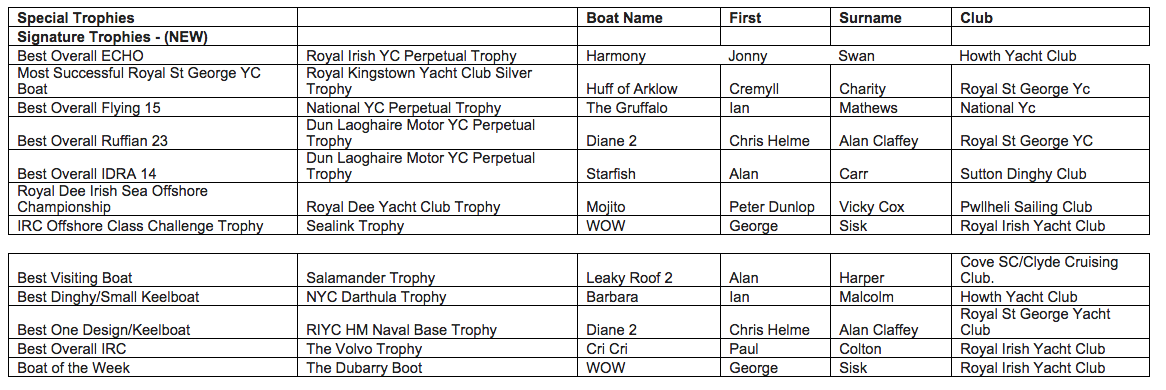
#vdlr –With an entry list the envy of regatta organisers everywhere, July's Volvo Dun Laoghaire Regatta (VDLR) has received a massive entry of 302 boats so far with three months to run to its first gun. Over 63 different yacht clubs are represented in a fleet that will split into 20 different sailing classes for the four day extravaganza at the Irish east coast port. Enthusiastic insiders say the tenth anniversary of the event may yet hit its all time high of 500 boats by July 9 but a more modest reckoning of 400 plus will certainly match the 2013 and 2011 editions of Ireland's largest sailing event.
Run by the four waterfront clubs of the DMYC, RIYC, NYC and RSt.GYC's this year's event is under the stewardship of former Fastnet race winner Tim Goodbody and Dragon Edinburgh Cup winner Martin Byrne. An overview of the biennial event was published by Afloat.ie last weekend in WM Nixon's blog here.
The bulk of entries come from the Dublin Bay area itself but there is also strong interest from along the east coast from Greystones, Arklow, Howth and Skerries. Most encouragingly, the event is proving to be a draw for boats from further afield too with entries from across the Irish Sea some of the first to sign up.
As previoulsy reported by Afloat.ie, the following events are confirmed as part of the event:
Royal Dee Yacht Club Irish Sea Offshore Championship
J109 Irish National Championship
RS Elite Irish National Championship
Beneteau First 21 Irish Championship
Wayfarer Irish National Championship
GP 14 Leinster Championship
J24 Leinster Championship
In encouraging news for dinghy sailing (that has separately been given a shot in the arm this year by local DBSC organisers), it looks like VDLR will also see a lift for centreboard classes. 2015 will see a record number of dinghies classes participating. In addition to the regular one designs such as the Mermaid, Flying 15, Squib, Fireball, IDRA 14 – organisers are welcoming the GP14, Wayfarer, RS200/RS400, Laser classes to the regatta with their own starts.
It is the first visit to the Regatta for the GP14 fleet and organisers are very much looking forward to welcoming the class, all of whom will be from visiting clubs from around the country. An expected entry of 40 GP14's are expected and they will be hosting their Leinster Championships as part of the Regatta.
The Wayfarers are returning after running their a successful UK Nationals within the 2011 Regatta and this year they will be running their Irish Nationals, an expected entry of 20 visiting Wayfarers are expected.
Big entries are also expected from both the Laser and RS fleets. It still remians to be seen if the PY class can muster sufficient numbers.
VDLR had issues recently with its online payment. To accommodate anyone who has had difficulties it has extended the early bird discounted entry fee offer deadline to Friday, April 17th.
Volvo Dun Laoghaire Regatta 2015 Notice Of Race (NOR) Download Here!
#dlregatta – Volvo Dun Laoghaire regatta Chairman Tim Goodbody has published the Notice of Race for the 2015 edition of Ireland's biggest sailing event. At this early stage, the following events have been confirmed as part of the Volvo Dun Laoghaire Regatta 2015:
• Royal Dee Irish Sea Offshore Challenge
• J109 Irish National
Championship
• RS Elite Irish National
Championship
• Beneteau First 21 Irish
Championship
• Wayfarer Irish National
Championship
• GP 14 Leinster Championship
• J24 Leinster Championship
In the notice of race published in time for November's weekend cruiser conferene in Galway, Goodbody confirms he is following the 'well proven format' of four days of racing commencing on the afternoon of Thursday 9th, and finishing Sunday afternoon 12th July.
The organising committee have taken on board the valuable feed-back from our 2013 regatta and are working hard to ensure an even more successful event for 2015.
The regatta is already in a position announce the continuing sponsorship of Title Sponsors Volvo Car Ireland and Spirit Motor Group, along with many "Premium" sponsors.
Feeder races have been organised from Scotland, Northern Ireland, Wales and the West coast of England, with free berthing for the duration of the regatta.
Volvo Cork Week Day Three & The Race to Find the Pressure
#corkweek – Unsettled weather provided changeable conditions for the third day of racing at Volvo Cork Week writes Louay Habib. The day started with bright sunshine and balmy conditions, causing a short postponement for many classes and light rain (honestly!) and a stiffer breeze was encountered during the day. With many classes now completing six races, the discard has kicked in and front runners have become more apparent. What is plainly obvious from the results is races and places are being contested by seconds. Volvo Cork Week is providing exciting, close racing and ashore the craic is the same as ever.
Fleet A, composing of the fastest racer cruisers, competing in IRC One and IRC Two took on the Windward Leeward Course, which was 3 miles south east of Roches Point. Once a northerly breeze had settled, the fleet got a clean start in Race 5 racing upwind towards the shoreline. The breeze was light and the first leg proved to be crucial. Peter O'Leary was calling tactics today on Marc Glimcher's Ker 40, Catapult (Baltimore SC). "We crossed the line on starboard tack and tacked as soon as we could to head for the area of pressure on the right hand side of the course. The race was all about finding that extra pressure to get ahead of the fleet and into clear air."
Peter's brother Nicholas O'Leary is tactician on Michael Boyd's Grand Soleil 43, Quokka (Royal Irish YC). "Mark Mansfield on the wheel and myself were in total agreement that the right would pay" commented Nicholas. "We had both seen this scenario in the 1720 Nationals and it was clear to us."
Catapult scored their fourth win in a row in Race 5 and ended the day leading IRC One for the series by six points. Andy Williams' Ker 40, (Yealm YC) won Race 6, to move into second position on countback, from Richard Matthews Hakes 42, Oystercatcher XXX (Royal Burnham YC).
Quokka were unstoppable today, winning both of today's races to open up an 8.5 point gap for the series in IRC Two. Tony Ackland's Dubois 37, Dark Angel (Swansea YSC) is still in second place but a solid performance by Conor Phelan's Ker 37, Jump Juice (Royal Cork YC) has lifted the team up to third.
Fleet B, consisting of IRC 3, IRC 4, IRC 5 and the Sportsboat Class enjoyed three races on the Olympic Course, near Roches Point. with over 40 yachts racing on a tight triangular course.
In IRC Three, Pat Kelly's J/109, Storm (Rush YC) still leads the class after an intense battle. Robert McConnell's, A35, Fools Gold was the winner in Race 5. The intensity of the combat was evident by the top four yachts were only separated by an astonishing 12 seconds. Last year's class champion, Ian Nagle's J/109, Jelly Baby (Royal Cork YC) was the winner of Race 6 by just 23 seconds from Storm. However, the Kelly family racing Storm, finished the day on top by winning the last race of the day.
"The Olympic Course is a real test, especially the gybe mark, where yachts are converging for a manoeuvre all at the same time. Just a few seconds can make the difference between first and fifth." Explained Joss Walsh, trimmer on Storm. "The overall game plan was to keep with the yachts around us and try and compete with them for speed and avoid errors, which would be very costly. Pat Kelly has four sons on board, Storm is a real family boat but we are quite a heavy crew, which has made racing difficult in light conditions. We are all here to enjoy very competitive racing and a few pints at the club afterwards. We are here to win but having fun is just as important."
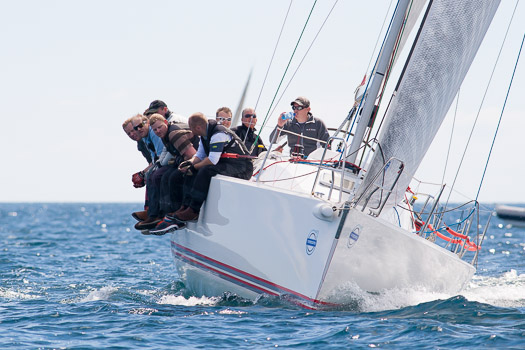
Former ICRA National Champion Storm leads IRC 3. Photo: Bob Bateman
Storm leads IRC Three by 10.5 points points from Paul O'Higgins Corby 33, Rockabill V, (Royal Irish YC). Jelly Baby is just half a point behind Rockabill V in third.
In IRC Four, Tim Cunliffe's Half Tonner, Insatiable (Royal Cornish YC) is the new leader having scored a 1,2,3 in today's three races. Paul Tingle's Corby 25, Alpaca (Royal Cork YC) has dropped to second place after struggling on today's Olympic Course. Peter Deasy's Bad Company (Royal Cork YC) had their best day so far, scoring a 4th and a win to move up to third in class. Ronan Fenton's J/35, Sky Hunter (Blackwater SC) finished the day in style, taking their first win of the regatta in Race 7.

Dave Lane and Sinead Enright's YaGottaWanna. Photo: Bob Bateman
In IRC Five, it is now six straight bullets to the boys from Cobh. Jason & Domonic Losty's Quarter Tonner, Illes Pitiuises (Cobh SC). However, the team have had to fight for their supremacy, winning Race 5 by 6 seconds and Race 6 by 35 seconds. Kieran O'Connell's Quarter Tonner, Bandit (Royal Cork YC) had a consistent day to have a solid position in second place for the series. Frank O'Regan's Orient Express (Cobh SC) is the smallest keel boat at the regatta and lies third, just one point ahead of Lane & Enright's J/24, Yagottawanna (Royal Cork YC).
In the Sportsboat Class Robin & Ben O'Mahony's 1720, Spiced Beef still leads the class after scoring a third and a race win today but two yachts came into the running with excellent results today. Julian Cook's Viper 640, Oh No, won the first two races putting pressure on Spice Beef but a fifth in the last race means that Spiced Beef have a five point lead for the series. Denis Murphy's 1720, Aquatack scored three second places today to move up to third for the class, just a point behind Oh No.

Lenny Donnery's No Knomes. Photo: Bob Bateman
In IRC One White Sail, George Pettifor's Beneteau 36.7, Foxtrot had an outstanding day in Cork Harbour, winning both of today's races to become the new class leader. John Downing's Samba drops to second place, just two points off the lead. Peter O'Donovan's X-372, X Tension scored a second and third place today to move up to third for the class.
Tom McNeice's Sigma 33, Minx III won both of today's races to open up a three point lead in in IRC Two White Sail. David Borry Crockett's Sigma 33, is second with Pat Vaughan's Contessa 33, Aramis in third.
Tonight's entertainment at the Royal Cork Yacht Club Event Village includes, traditional Bag Pipes from Sessiun Ceol followed by DJ Fadd Jnr, mixing the tunes after 10pm. Racing continues tomorrow, full results available here

Ted Crosbie at the tiller of No Excuse. Photo: Bob Bateman
#corkweek – Thrilling conditions welcomed an international fleet of yachts from all over Europe and the United States to Volvo Cork Week. 100 yachts racing in Cork Harbour produced a magnificent spectacle writes Louay Habib. Cork Harbour is one of the largest natural harbours in the world and provides stunning scenery and tricky wind and tidal conditions. The gusty north easterly breeze tested the boat handling skills of the international fleet, with several yachts reporting a boat speed of up to 20 knots on the surf.
The first race of Volvo Cork Week started just outside Roches Point, the wind speed piped up to 17 knots with a short sea state. The beat into Cork Harbour had the fleet swapping tacks past Spike Island, before negotiating close tight reaching legs along the picturesque town of Cobh. For many it was a race of over three hours, before returning to the Royal Cork Yacht Club to enjoy the full facilities of the exclusive race village.
Michael Boyd racing Grand Soleil 43, Quokka (Royal Irish YC) had an outstanding race, winning IRC Two by a landslide 15 minutes on corrected time. Tony Ackland's Dubois 37, Dark Angel (Swansea YSC) was second in IRC Two, just seven seconds ahead of Jim Macgregor's Elan 410, Premier Flair (Poole YC), which made an impressive comeback after starting prematurely.
For Volvo Cork Week, Mark Mansfield (Royal Cork YC) is at the helm of Quokka. Mark sailed at four consecutive Olympics from 1992 to 2004, for Ireland, in the International Star Class.
"We got a great start, there was a wind shift just before the gun, which favoured the pin end and we had a nice approach and tacked soon after into clear air." Explained Mark. "The wind speed was up and so was the sea state and Quokka just loves those sort of conditions. Heavier than the Ker 40s, she goes well through the waves but downwind Quokka doesn't plane, so the Ker 40s got away. The crew work today was very good, especially after some last minutes calls; it's obvious that this team has been training well together for the Commodores' Cup."
Anthony O'Leary's Ker 39, Antix (Royal Cork YC) started well and played the current and the wind acceleration through Roches Point to lead on corrected time at the top mark off Cobh. Marc Glimcher's Ker 40, Catapult (Baltimore SC) helmed by Royal Cork's Olympian Peter O'Leary, took Line Honours by 27 seconds from Richard Matthews' Hakes 42, Oystercatcher XXX (Royal Burnham YC) . However, after time correction, Antix won the class by less than a minute from Catapult with Andy Williams' Devon based, Ker 40, Keronimo in third.

Victory in IRC Three went to Pat Kelly's J/109, Storm (XXYC). Paul O'Higgins Corby 33, Rockabill V took line honours but after time correction Storm won by nearly three minutes from Robert McConnell's A35, Fools Gold with Rockabill V third.
The IRC Four Class winner for 2012 was in fine form today. former Royal Cork YC Admiral, Peter Deasy driving Bad Company scored a slender win from Paul Tingle's Corby 25, Alpaca (Royal Cork YC). Tim Cunliffe and his team from Falmouth, racing Half Tonner, Insatiable was third.
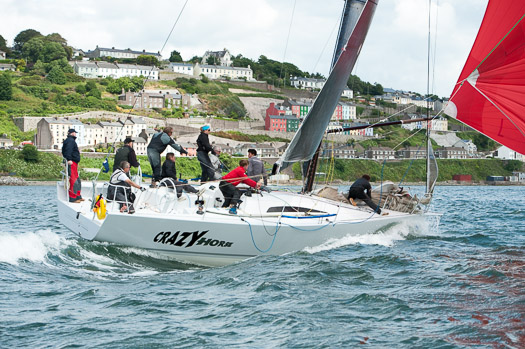
Bad Company won by just 49 seconds on corrected time. "Beautiful conditions and a really competitive race, what a great start to Volvo Cork Week." Smiled Peter Deasy. "We are delighted to see Insatiable back, we had a great battle with them last time and Paul's new boat, Alpaca, is sailing very well indeed, so we will have to be at our best to win this class."
It was a long day on the water in IRC Five, Jason & Domonic Losty's Quarter Tonner, Illes Pitiuises was the winner by just under five minutes from Dave Lane & Sinead Enright's J/24, YaGottaWanna. Christine Willis's Westerly Fulmar, Rodmar was one of the last yachts to finish today, after over four hours of racing, the team from Aberaeron SC showed great tenacity taking third in class after time correction.
In White Sail IRC One, Bryan Hefferan's Dufour 36, Aisling (Royal Cork YC) took Line Honours and the class win on corrected time from John Downing's Sunfast 32, Samba. Peter O'Donavan's X-372, Xtension (Royal Cork YC) was third.
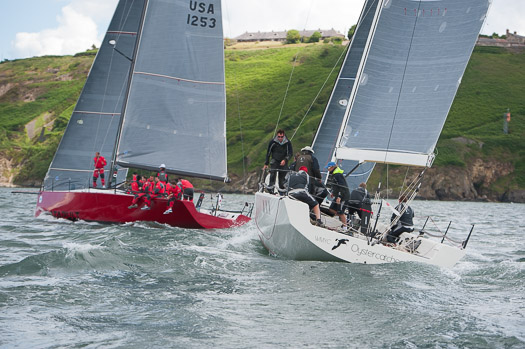
In the Sportsboat Class, Robin & Ben O'Mahony's 1720, Spiced Beef was the winner with Mike Relling's Viper 640, Viper taking second place and David Pitman's Viper 640, The Black Adder was third. Viper could have won the first race but for a navigational error. "We over stood a mark, which cost us the lead and ultimately the race." Admitted Viper's skipper, Mike Relling. "We had a real blast though, hitting 19 knots on the reach and it has been great to race against the 1720s. They definitely have us upwind but downwind the Viper is much quicker, so we expect a regatta-game of snakes and ladders, pardon the pun!" David Pitman's Viper 640, The Black Adder was third.
After racing, hundreds of competitors enjoyed a few glasses at the Royal Cork Yachjt Club with live entertainment. The SLAM Crew Games kick off tonight in the Marquee with a giant screen showing the FIFA World Cup Semi-Final between Brazil and Germany. Racing continues at Volvo Cork Week tomorrow Wednesday 8th July, with the international fleet enjoying a variety of courses both inside and outside of Cork Harbour.
For full results here
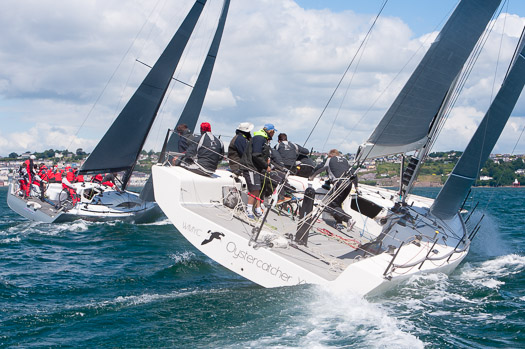
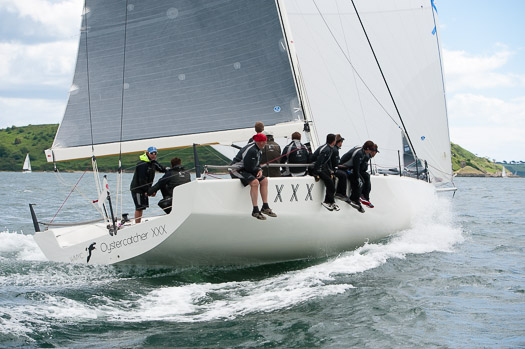
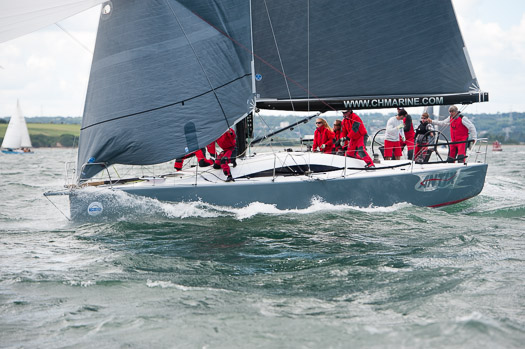

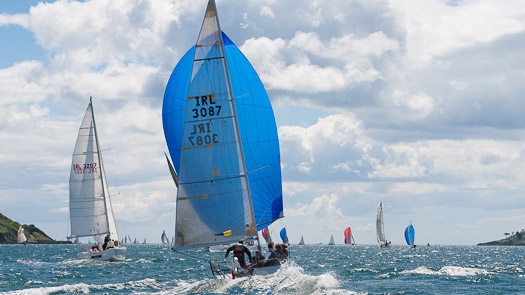
Commodore's Cuppers Line Up for Volvo Cork Week
#corkweek – With Volvo Cork Week taking place just two weeks before this summer's Dolphin Commodores' Cup, competing teams are eyeing up Volvo Cork Week as an ideal training event for the inter–country competition.
Early entries for Volvo Cork Week are promising a wide variety of sailors and yachts coming to enjoy, Ireland's longest running regatta. Interest has been received from several high performance yachts from overseas and
Half of the early entries for Volvo Cork Week are from Dublin Yacht Clubs, promising signs of a strong Irish presence, looking to take on well sailed overseas visitors.
Maurice 'Prof' O'Connell will be crew boss for the Grand Soleil 43, Quokka, at Volvo Cork Week. Quokka, co-skippered by Niall Dowling and Michael Boyd will be part of the Irish team at the Brewin Dolphin Commodores' Cup. " Cork Week will be our last event before the Commodores' Cup." confirmed Prof. "We will have the full team racing the boat and we will be flying the flag in Ireland for the last time before the big event based in Cowes. Cork Week provides the perfect preparation in terms of the different types of course and I believe their will be a number of races each day, so we will be leaving the dock before 9 a.m. and out on the water until after 4 p.m. Essentially we will be spending a full day on the water, taking part in races that are very similar to our main event, Cork Week will mimic the Commodores' Cup inshore races, there is no more an ideal preparation for us to bring the team to the boil."
Cork Week is famous for fantastic race courses set in the Atlantic Approaches and Cork Harbour, providing a variety of racing that is difficult to better. However, the X-Factor at any successful regatta comes from the people who take part and Volvo Cork Week has characters in abundance. Every team comes to Volvo Cork Week looking for success but the legendary 'Cork Craic' is just as appealing as the racing.
British sailor, Andrew Jones now lives with his young family in Dublin. Andrew will be the skipper of X-43, Fox in Sox for Volvo Cork Week.
"We've managed to scrape together a motley crew of elderly Dublin Bay racers, sleep-deprived Dads, anti-social short-handed offshore guys, Fastnet novices, oh and a former hot-shot Italian helm." commented Andrew. "We're looking forward to our first Cork week with Fox in Sox and hope to have some laughs...and we might just be one to watch if we can make our boat fly! I have put the crew together from contacts made during the 2011 Fastnet campaign and friends at the Royal Irish Yacht Club. I'm the only Brit, the rest are Irish and Italian. Some of the crew have done Cork week before on other boats but this will be my first time. It's the major Irish regatta this year, so it's a must do for us."
Tony Kingston's 33ft Dehler, Luv Is, from Kinsale was one of the first entries, Tony and his wife Alice, a former Commodore of Kinsale Yacht Club, and have competed many times at Cork Week.
Alice trims mainsheet upwind and spinnaker downwind. She has completed thousands of miles of cruising and racing and has the reflexes of a mongoose, having put up with my helming for longer than we care to remember!" laughed Tony. "Choryna handles the pit and helms her own Dragon when she is not sailing with us but the iffy clutches and wonky winches are no bother to her. Miah, a cattle rancher from West Cork, takes care of the bow. He prefers heavy weather and is never happier than when the wind is high. He has done at least five Round Ireland's and a few Fastnet races and prefers offshore racing but will tolerate the short races. He has no interest whatever in how we do in a race: Times, results, classes and handicaps do not interest him at all. Two Laser sailors in their twenties complete the line up, giving the team a big input into tactics, they can read the race and the race area better than the previous generation most of the time.
My tuppence worth of advice for first timers at Cork Week, is to sail conservatively and prudently on day one. Give way early and avoid damage at all costs. Whether right or wrong, damage will ruin your week. Better to give up half a boat length than spend the day at the protest room or boat yard. Everyone is more relaxed after the first day. Also, remain civil afloat, as you will meet ashore at some stage and you may well find that you spend the whole week afloat with the same small group of boats, as if tied by an invisible string. Much better to make friends day one and enjoy it. We still meet friends we made on the water twenty years ago."
Gavin Deane, General Manager of the Royal Cork Yacht Club commented on the affect that the title sponsorship from Volvo will have on the event.
"Having Volvo as partners for Cork Week is fantastic news for the competitors." commented Gavin. "The Royal Cork Yacht Club will be investing all of the funds towards Volvo Cork Week. The money will be used to support great race courses and the partnership has enabled us to vastly reduce the entry fees. The minimum saving for boats will be 40% and as much as 70% in some cases. The club will also be giving complimentary car parking to competitors, which has been an issue in the past, and providing more afternoon entertainment. When people are coming in off the water, soul bands and other live music will be playing, hopefully the weather gods will smile on us and after great racing, there will be a great Craic ashore. Those are the goals for Volvo Cork Week 2014."
Royal Cork Yacht Club Boost as Volvo Sponsors Cork Week
#corkweek – Royal Cork Yacht Club has described the weekend signing of its new sponsor for Cork Week as 'a new chapter' for Ireland's longest running international regatta week. News of the new title sponsorship broke on Friday.
Cork Week is recognised as one of the premier regattas in Europe and the Royal Cork Yacht Club is very proud to continue to host this event since its inception thirty six years ago. John Roche, Vice Admiral Royal Cork Yacht Club and Chairman of Volvo Cork Week, is looking forward to welcoming many old friends who have been coming to Crosshaven for many years and of course also looking forward to welcoming new competitors to this premier event. Racing on Cork Harbour's world famous courses will, as always, be under the direction of Anthony O'Leary, renowned national and international sailor.
Adrian Yeates, Managing Diretor Volvo Ireland Ltd said at the weekend launch: "Cork Week has enjoyed a long and illustrious history, both on the Irish and international sailing calendar. Volvo Car Ireland, in conjunction with Johnson and Perrott Motor Group, is proud and delighted to add its name to this prestigious event. Volvo has invested heavily in the sailing arena over the years and Ireland benefitted greatly from the visit of the Volvo Ocean Race to Galway for the last two round the world races. Volvo Cork Week will be one of the biggest sailing event to take place in Ireland in 2014 and next year will be the turn of the Volvo Dun Laoghaire Regatta which we have sponsored since 2007. We are looking forward to an exciting programme in Crosshaven in July and welcoming sailors and visitors alike
In 2014, conscious of the economic environment, there will be a substantial reduction in the entry fees and the format of the event will change from five to four days, Tuesday to Friday inclusive with Monday being a practice day for those wishing to avail of this. Volvo Cork Week 2014 will strive to include ten races and will continue to offer free berthage and a free car parking space for the duration of the event.
Of course there will be the usual variety of courses set in open water, coastal and in the harbour which should test crew handling and get just about every sail out of the bag .
In recent years, Two-Handed racing has become increasingly popular all over the world and Volvo Cork Week will recognise this by introducing a two handed class for the first time. The Sir Thomas Lipton Cup is one of the Royal Cork Yacht Club's most famous awards and the trophy, dating back to 1900 will be awarded to the best yacht in this class. Also, by its very nature, sailing short handed reduces accommodation and living expenses for a competing yacht.
The Royal Cork Yacht Club, the oldest yacht club in the in the world, looks forward to extending a warm welcome to all sailors who come to visit and would like to extend good wishes to all for a very enjoyable and safe regatta.
#corkweek – July's Royal Cork Yacht Club's Cork Week regatta will share the same title sponsor as Dun Laoghaire regatta according to this morning's Irish Times Sailing Column. It's a move that gives the Swedish car marque the headline name to both of Ireland's big sailing events. As previously reported by Afloat.ie, the Crosshaven event has had a number of key changes to its format for 2014 aimed at reducing costs for both competitors and organisers alike.
The new sponsorship deal will be a shot in the arm for the biennial event that is Ireland's longest running international regatta, a sporting event that became a global name in the nineties when competitor boat numbers reached 700 in 1998 to rival the UK's Cowes week regatta.
Royal Cork's John Roche is to chair the new week with top Cork helmsman Anthony O'Leary in charge of the famous Cork Week courses.
The J109 fleet will race for national honours as part of the week and a new trophy for short handed competition is also to be introduced. Royal Cork's own 1720 sportboat fleet will also be racing.
The Irish Times has more on the story here.




























